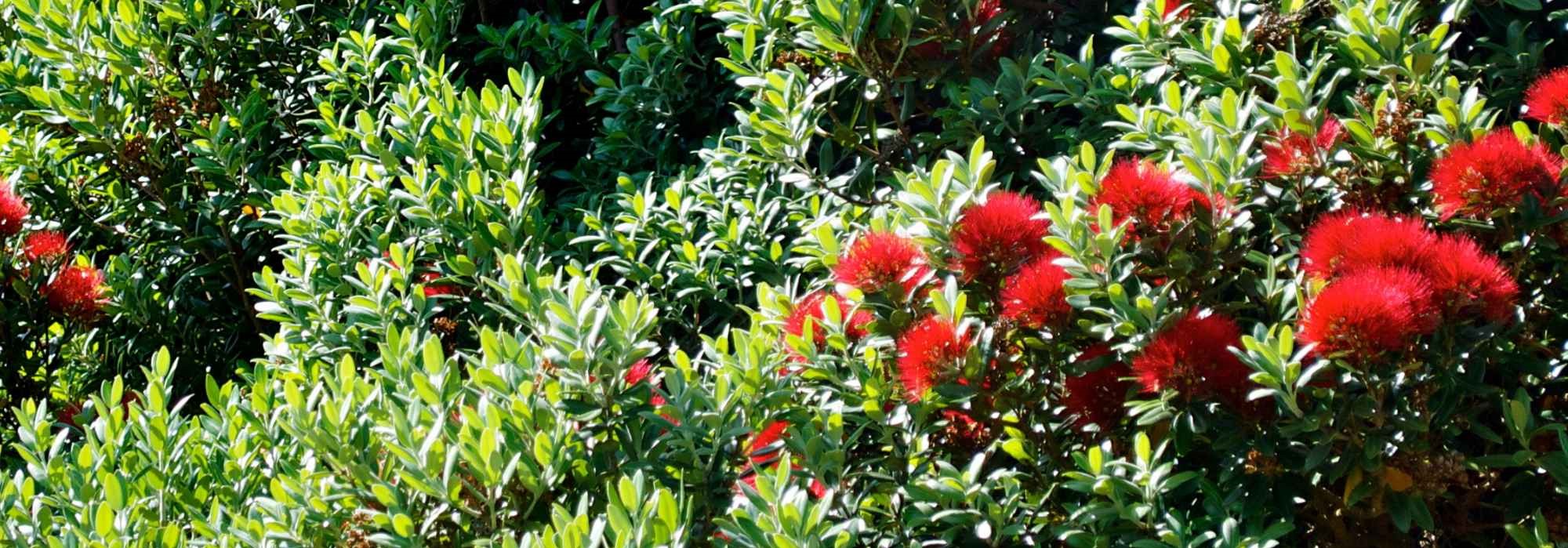
Metrosideros: planting and growing
Contents
Metrosideros in a few words
- Metrosideros is a magnificent New Zealand tree
- It blooms with large red pompons, hence its nickname as the Christmas tree
- Frost-sensitive, it is a large evergreen bush for mild climates
- In cooler regions, it will be grown in containers so it can be brought indoors in winter
- It is an ideal plant for coastal and southern gardens, as well as a stunning conservatory plant
The word from our expert
The Metrosideros, nicknamed pohutukawa in its native New Zealand, is a beautiful evergreen bush ideal for mild and coastal climates. Indeed, it is highly sensitive to cold, suffering at temperatures as low as -3/-4°C. In summer, its lush green or attractively variegated foliage is covered with a profusion of bright red flowers, resembling small incandescent pom-poms, much like the Metrosideros excelsa. In its homeland, it blooms at Christmas, earning it the nickname of Christmas tree.
Due to its low hardiness, its cultivation methods vary from region to region. Planting in the ground is reserved for mild, oceanic, or Mediterranean climates. Elsewhere, it should be grown in large containers so it can be overwintered frost-free, much like an orangery plant. In less harsh regions, in the garden, it thrives in full sun, tolerates sea spray, and prefers fresh but well-drained soil.
Discover this bush with its wildly exotic appearance!
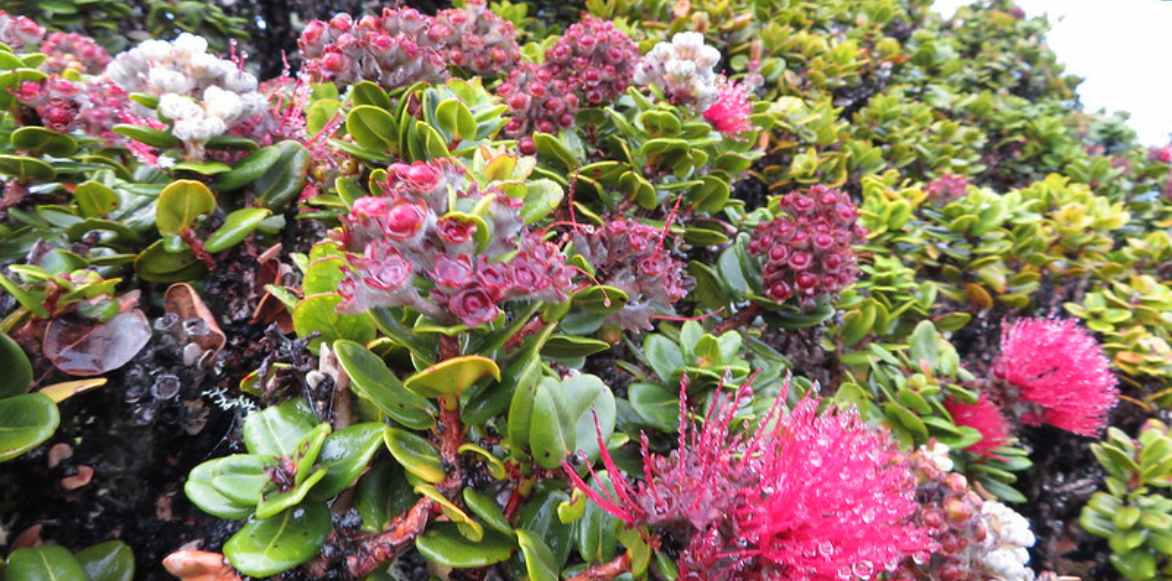
Metrosideros polyphorma (© Forest and Kim Starr)
Description and Botany
Botanical data
- Latin name Metrosideros
- Family Myrtaceae
- Common name New Zealand Christmas Tree
- Flowering June to August
- Height 1 to 3 m
- Exposure Sun
- Soil type Light, fresh, well-drained
- Hardiness -3-4 °C
The genus Metrosideros comprises around fifty species of trees, bushes, and lianas belonging to the Myrtaceae family, such as theEucalyptus, theCallistemon, and theLeptospermum. They are primarily native to New Zealand, but some have naturalised in many subtropical regions and the Pacific Islands, where they grow in scrub vegetation, forests, and on volcanic coasts, colonising lava and altitudes up to 1,000 m. From their origins, Metrosideros retain a certain sensitivity to cold. The Metrosideros excelsa (nicknamed the New Zealand Christmas Tree or pohutukawa in Māori) and its forty or so cultivars and hybrids are the most widespread species in gardens with mild winters. TheMetrosideros kermadecensis or Kermadec Metrosideros is another species suited to mild climates, originating from the volcanic Kermadec Islands. The Metrosideros umbellata is the most cold-resistant species (-12 °C) and thus the best adapted to cooler climates and moist soils. As for the Metrosideros carminea, it is a tender climbing species reaching 15 m in height.
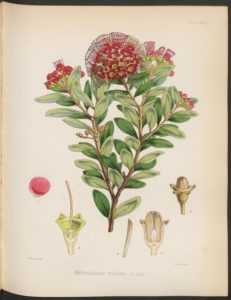
Metrosideros robusta, botanical plate from 1840
In their natural habitat, Metrosideros form bushes or beautiful trees, sometimes reaching up to 20 m in height with trunks measuring up to 2 m in diameter. They are rarely very large. In our regions and gardens in the south or along the Atlantic coast, they will remain much smaller, rarely exceeding 6 m in height and 5 m in width at maturity. Specimens grown in containers, as they are excellent subjects for pot cultivation, show even more modest growth. Their growth is slow (around 3 m in 10 years), making them ideal for container cultivation.
They are long-lived, surviving for over 200 years! Their habit varies depending on the species and variety, but the foliage is naturally dense. Upright and compact in their youth for most, they develop a parasol-like shape with age. Some exhibit a creeping or climbing habit. They grow on a powerful and deep root system. They boast a beautiful corky bark, grey-brown in colour, with gnarled trunks and branches. The wood is dark and very hard, earning these trees their name, derived from the Greek “metra” (heartwood) and “sideros” (iron). For centuries, the Māori have used it for carving. The Metrosideros excelsa and its descendants have the unique feature of aerial roots, which sometimes take root in the ground. Some species are even epiphytic, starting life on the branches of host trees before developing roots.
Metrosideros are beautiful evergreen bushes, decorative in all seasons. They bear small, leathery, evergreen leaves, downy and white on the underside. They are single, opposite, lanceolate or oblong, with slightly undulate margins, long and narrow, measuring 2 to 10 cm. They sometimes take on a silky appearance, becoming pubescent before turning glabrous after the spring bud burst. Most are dark olive green, but some cultivars, such as ‘Sunninghill’ and ‘Aureomarginata’ (syn. ‘Variegata’), display irregular yellow variegation.
Metrosideros are remarkable for their flowering, as original as it is dazzling, occurring around Christmas time in the Southern Hemisphere, earning them the vernacular name “New Zealand Christmas Tree.” Perhaps also due to their flowers resembling large scarlet pom-poms, reminiscent of Christmas baubles. Covering the entire tree, these upright inflorescences give the plant a spectacular appearance. From May to August, in our latitudes, small flowers clustered in cymes at the tips of the branches display their bouquets of prominent, often scarlet stamens, about 3 cm long. Like compact bottlebrushes, they resemble those of the Callistemon. These feathery floral spikes, almost fluorescent, occasionally sport softer or different hues, ranging from white to orange.
Their long stamens, beautifully dusted with golden-yellow pollen, are melliferous and nectariferous, attracting numerous pollinating insects like bees, as well as certain birds. The flowers later turn into small, 8 mm diameter dehiscent capsules containing numerous winged seeds dispersed by the wind.
The flowering pōhutukawa symbolises summer in New Zealand. The country’s most famous specimen is believed to be around 800 years old! The M. excelsa is a sacred tree for the Māori, who believe the spirits of the dead descend through its roots to reach the island of their ancestors.
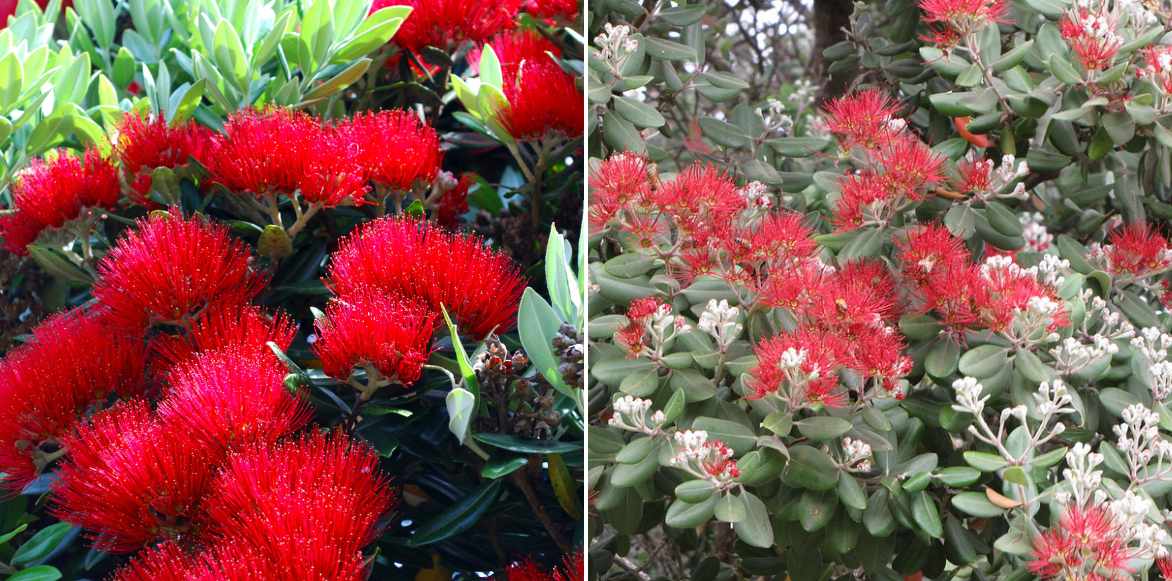
Metrosideros excelsa on the left, and Metrosideros kermadecensis on the right (© Forest and Kim Starr)
Main species and varieties
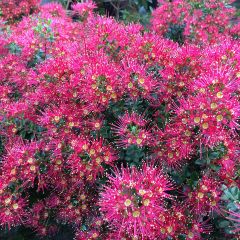
Metrosideros carminea Ferris Wheel
- Période de floraison June to August
- Hauteur à maturité 90 cm
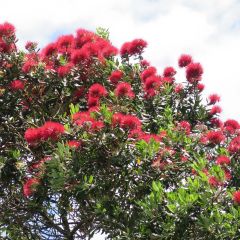
Metrosideros excelsa
- Période de floraison July to September
- Hauteur à maturité 2 m
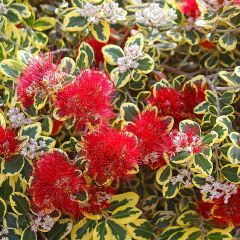
Metrosideros kermadecensis Sunninghill
- Période de floraison August, September
- Hauteur à maturité 3 m
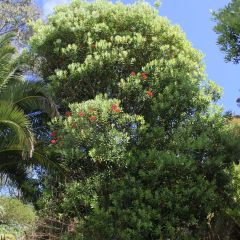
Metrosideros Mistral
- Période de floraison July to September
- Hauteur à maturité 2,50 m
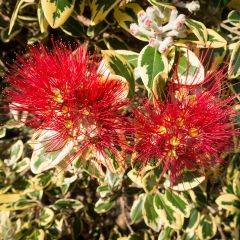
Metrosideros kermadecensis Aureomarginata
- Période de floraison June to August
- Hauteur à maturité 2 m
Planting the Metrosideros
Where to Plant It?
Originating from New Zealand, the Metrosideros retains a strong sensitivity to cold. It is best planted in the ground in coastal and southern gardens where frost is neither severe nor prolonged. This limited hardiness (generally -3 to -5°C, -6°C at worst) restricts its cultivation to the coastal areas of Brittany, the southern Atlantic coast, and the French Riviera. Its hardiness is further compromised in damp soil or when exposed to icy winds. For this reason, outside the most sheltered gardens, it is grown as an orangery plant, in large containers so it can be overwintered frost-free. It makes an excellent greenhouse or unheated conservatory plant, or can be placed indoors behind a well-oriented glass door, and can be moved outdoors during the warmer months.
Nicknamed “splashed by the sea” by the Maori, this tree is highly resistant to salt spray and adapts effortlessly to coastal gardens. In regions where frosts are brief and mild, plant it in the ground in rich, ordinary soil (not overly chalky), moist but well-drained. While it can grow in relatively dry soil, it prefers soil that remains sufficiently moist in summer. Be mindful of watering in dry climates. Once established, it will show increased drought resistance. It needs full sun to flower well, though it tolerates partial shade in the sunniest regions. Choose a warm, sheltered spot away from cold winds.
Plan for its eventual size! Although slow-growing, carefully consider its planting location, as some varieties can reach 6m in height and 5m in spread at maturity. Its extensive and robust root system makes it difficult to transplant later.
In Mediterranean gardens, the Metrosideros can be planted as a focal point or at the back of an exotic border to showcase its beauty. In colder climates, placed in a pot on a sunny terrace or balcony, it will add an exotic touch.
When to Plant?
Planting a Metrosideros is best done in April-May, once the risk of frost has passed, allowing it to establish roots before winter.
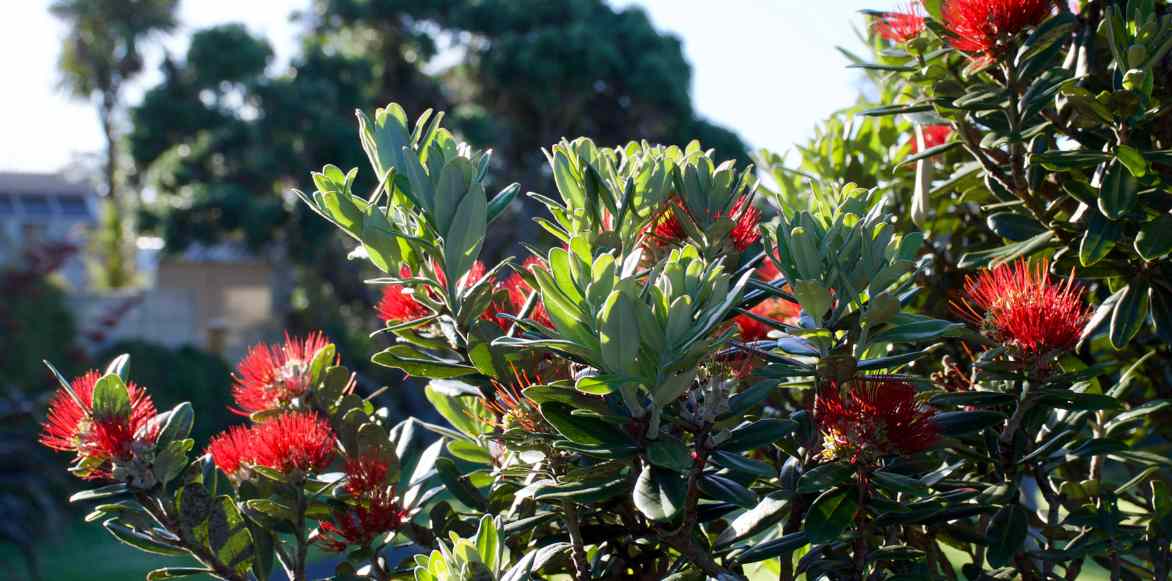
Metrosideros excelsa
How to Plant It?
In the Ground
If your soil is very chalky, I recommend adding some heather soil to your garden soil.
- Soak the root ball in a bucket of water for 15 minutes to rehydrate it thoroughly
- Dig a hole at least 80cm wide and deep
- Spread a thick layer of clay pebbles or gravel at the bottom
- Plant the bush upright in the centre of the hole
- Fill with a mix of heather soil, compost, and garden soil in equal parts. Add a few handfuls of river sand.
- Firm the soil with your foot
- Water generously after planting
In a Pot
Good drainage is essential.
- At the bottom of a pot at least 50cm in diameter, spread a thick layer of gravel, pumice, or clay pebbles for drainage
- Plant in a light substrate made of river sand, heather soil, and leaf compost
- Water thoroughly
Maintenance, pruning and care
The Metrosideros is very sensitive to cold, making it easy to cultivate in Mediterranean regions or along the mild-wintered Atlantic coast.
- When planted in the ground, it appreciates having its roots kept cool in summer: watering (preferably with rainwater) should therefore be abundant and regular (on average once or twice a week) to maintain moisture at the base, without excess. The soil should not dry out in summer during the first few years after planting. A mulch at the base can help reduce watering and retain sufficient moisture. Later on, this tree will tolerate some soil dryness well. For the first few winters, protect the stump with a thick organic mulch and, if necessary, shield the aerial parts from frost with a winter fleece.
- In pots, it will require more care and attention. Water very regularly with non-calcareous water throughout the summer, but never saturate the substrate. The soil should never dry out completely either. Don’t hesitate to mist the foliage during very hot weather. In spring and autumn, to encourage growth, apply a good slow-release fertiliser. At the first signs of cold, move the pot to a cold greenhouse or a bright, frost-free room where the temperature will not drop below 5°C. Being adaptable, it can also spend the winter indoors in a heated room. Reduce watering to about once a month, allowing the soil to dry out between waterings. Bring the pots back outside when frost is no longer a risk. Repot once a year in spring. Later, when its size makes repotting too difficult, simply renew the substrate with an annual top-dressing.
When and how to prune a Metrosideros?
A simple annual maintenance pruning is sufficient for this slow-growing bush. It helps stimulate flowering and growth while maintaining a dense, attractive silhouette by correcting its habit.
- In autumn or after flowering, use pruning shears to remove dead or misplaced branches.
- Overgrown specimens can be kept in check with a severe annual cutback, making them easier to move indoors.
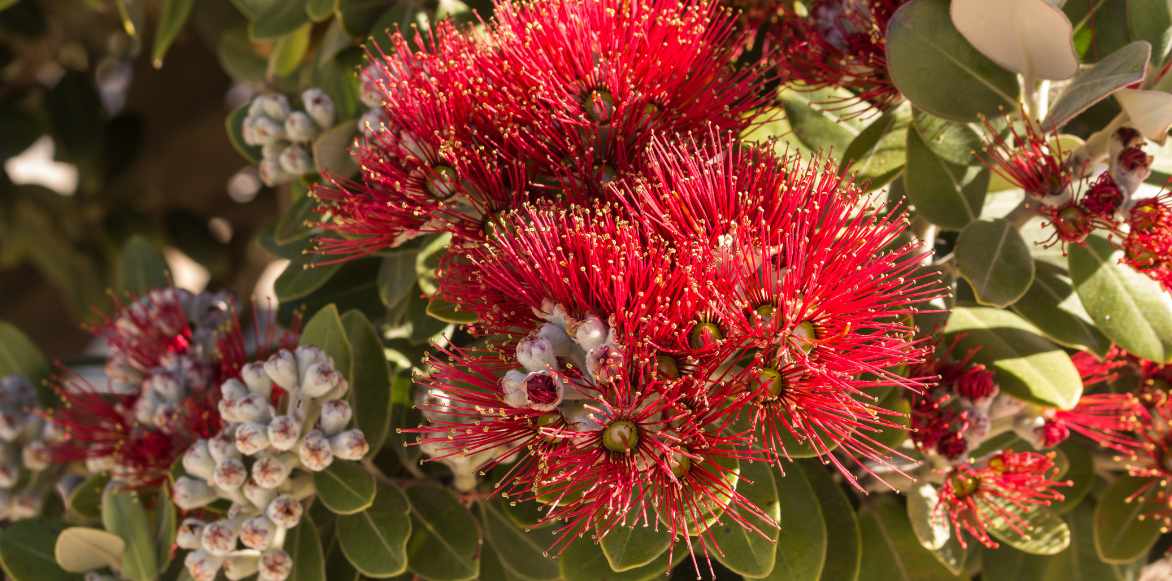
A stunning flowering display!
Diseases and potential parasitic issues
Relatively resistant to pests and diseases, when grown indoors, the Metrosideros can become vulnerable to scale insects. In such cases, apply rapeseed oil sprays, repeating two or three times at 15-day intervals. If invaded by aphids, spray with soapy water.
In overly chalky soil or due to excess water, its foliage may turn yellow. Good drainage and regular additions of heather soil by scratching around the base of the bush can prevent this issue.
Multiplication
To ensure the longevity of the Metrosideros, propagation by sowing can be done in warm conditions during spring, but flowering will only occur after many years. We recommend propagation by cuttings in summer as the simplest and quickest method to multiply your tree.
- In late summer, take semi-hardwood cuttings (partially hardened) measuring 10 to 15 cm
- Remove the leaves from the lower third of the stems
- Plant them in a light, well-draining mixture of sand and compost
- Water
- Place under a humidity dome until rooting occurs
- Keep the substrate moist
- Transplant your cuttings into individual pots once they are sufficiently rooted
- Plant them in pots or directly in the ground the following spring
- To encourage establishment, water thoroughly during the first year after planting
Associate
With its incandescent flowering throughout the summer and its tropical allure, the Metrosideros is an essential bush in Mediterranean gardens, along the Atlantic climate coastline, or in exotic-themed landscapes. It will make a striking centrepiece in an original and vividly colourful summer scene.
Planted at the back or centre of a bed of low-growing plants, it will look sensational surrounded by sun-loving perennials such as the bird of paradise, echinaceas, and coreopsis, and exotic bushes like the Syagrus palm, hardy banana trees, or the Eucalyptus ‘Baby Blue’. Consider ground-covering plants to place at its base, such as a creeping ceanothus and creeping rosemary.
Pair it with its Australian cousins like the Phormium, and Grevillea, or New Zealand natives like the Callistemon and Leptospermum, which boast equally vibrant flowering.

Metrosideros excelsa, Phormium ‘Apricot Queen’, Leptospermum scoparium, and Grevillea
Useful resources
- The most beautiful collection of Metrosideros can be found in our nursery!
- Planting and growing Australian plants, all our tips!
- Subscribe!
- Contents































Comments